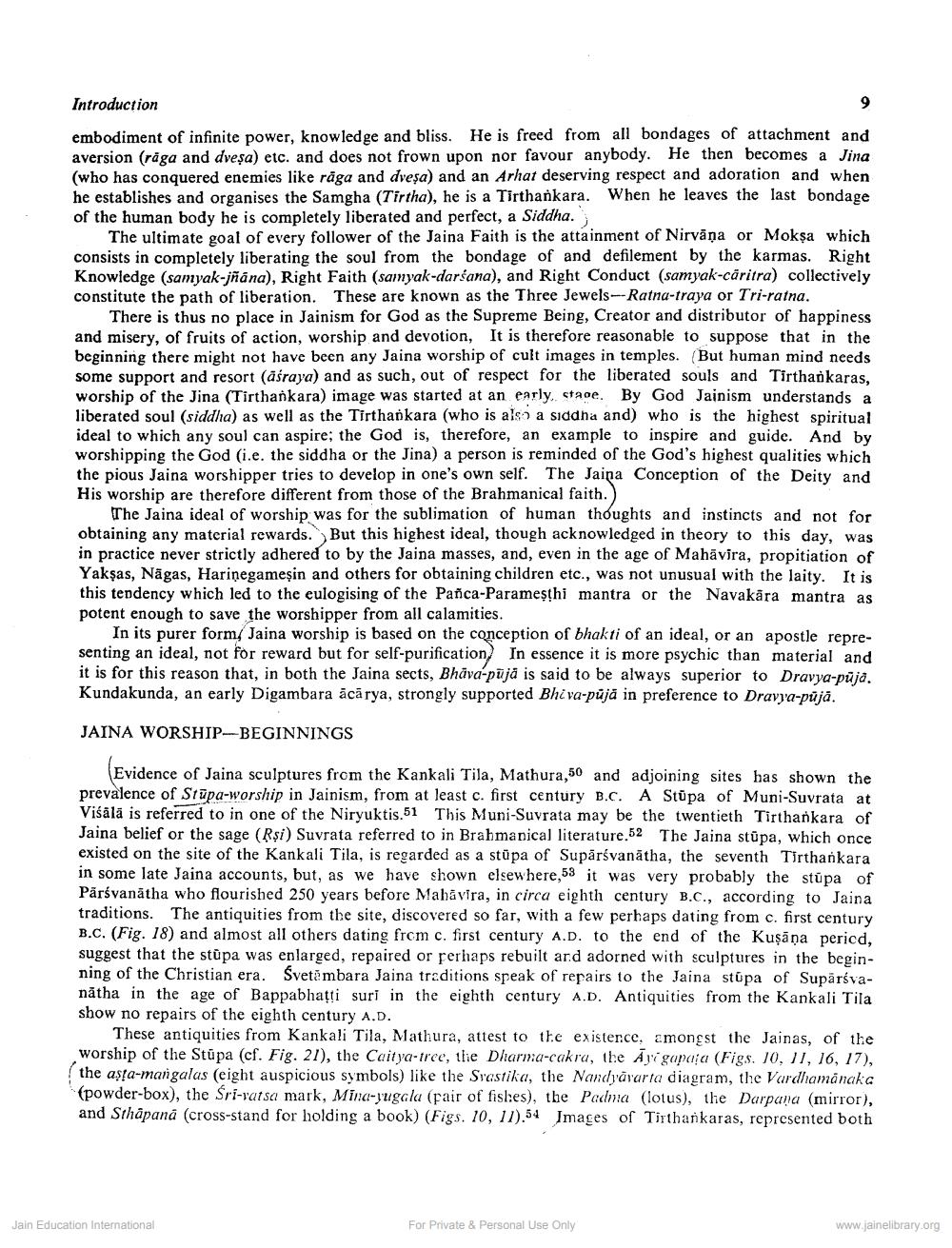________________
Introduction
9
embodiment of infinite power, knowledge and bliss. He is freed from all bondages of attachment and aversion (räga and dveṣa) etc. and does not frown upon nor favour anybody. He then becomes a Jina (who has conquered enemies like räga and dveşa) and an Arhat deserving respect and adoration and when he establishes and organises the Samgha (Tirtha), he is a Tirthankara. When he leaves the last bondage of the human body he is completely liberated and perfect, a Siddha.
The ultimate goal of every follower of the Jaina Faith is the attainment of Nirvāņa or Mokṣa which consists in completely liberating the soul from the bondage of and defilement by the karmas. Right Knowledge (samyak-jñāna), Right Faith (samyak-darśana), and Right Conduct (samyak-caritra) collectively constitute the path of liberation. These are known as the Three Jewels--Ratna-traya or Tri-ratna.
There is thus no place in Jainism for God as the Supreme Being, Creator and distributor of happiness and misery, of fruits of action, worship and devotion, It is therefore reasonable to suppose that in the beginning there might not have been any Jaina worship of cult images in temples. (But human mind needs some support and resort (asraya) and as such, out of respect for the liberated souls and Tirthankaras, worship of the Jina (Tirthankara) image was started at an early stage. By God Jainism understands a liberated soul (siddha) as well as the Tirthankara (who is also a siddha and) who is the highest spiritual ideal to which any soul can aspire; the God is, therefore, an example to inspire and guide. And by worshipping the God (i.e. the siddha or the Jina) a person is reminded of the God's highest qualities which the pious Jaina worshipper tries to develop in one's own self. The Jaina Conception of the Deity and His worship are therefore different from those of the Brahmanical faith.)
The Jaina ideal of worship was for the sublimation of human thoughts and instincts and not for obtaining any material rewards. But this highest ideal, though acknowledged in theory to this day, was in practice never strictly adhered to by the Jaina masses, and, even in the age of Mahavira, propitiation of Yaksas, Nāgas, Harinegameşin and others for obtaining children etc., was not unusual with the laity. It is this tendency which led to the eulogising of the Pañca-Parameşṭhi mantra or the Navakara mantra as potent enough to save the worshipper from all calamities.
In its purer form, Jaina worship is based on the conception of bhakti of an ideal, or an apostle representing an ideal, not for reward but for self-purification In essence it is more psychic than material and it is for this reason that, in both the Jaina sects, Bhava-puja is said to be always superior to Dravya-pūjā. Kundakunda, an early Digambara äcārya, strongly supported Bhiva-paja in preference to Dravya-pājā.
JAINA WORSHIP-BEGINNINGS
Evidence of Jaina sculptures from the Kankali Tila, Mathura,50 and adjoining sites has shown the prevalence of Stupa-worship in Jainism, from at least c. first century B.C. A Stupa of Muni-Suvrata at Viśālā is referred to in one of the Niryuktis.51 This Muni-Suvrata may be the twentieth Tirthankara of Jaina belief or the sage (Rşi) Suvrata referred to in Brahmanical literature.52 The Jaina stupa, which once existed on the site of the Kankali Tila, is regarded as a stupa of Supärśvanatha, the seventh Tirthankara in some late Jaina accounts, but, as we have shown elsewhere,53 it was very probably the stupa of Pārsvanatha who flourished 250 years before Mahavira, in circa eighth century B.C., according to Jaina traditions. The antiquities from the site, discovered so far, with a few perhaps dating from c. first century B.C. (Fig. 18) and almost all others dating from c. first century A.D. to the end of the Kuṣāņa period, suggest that the stupa was enlarged, repaired or perhaps rebuilt and adorned with sculptures in the beginning of the Christian era. Svetambara Jaina traditions speak of repairs to the Jaina stúpa of Supärsvanatha in the age of Bappabhatti suri in the eighth century A.D. Antiquities from the Kankali Tila show no repairs of the eighth century A.D.
These antiquities from Kankali Tila, Mathura, attest to the existence, amongst the Jainas, of the worship of the Stupa (cf. Fig. 21), the Caitya-tree, the Dharma-cakra, the Ayigapata (Figs. 10, 11, 16, 17), the asta-mangalas (eight auspicious symbols) like the Svastika, the Nandyavarta diagram, the Vardhamanaka (powder-box), the Sri-vatsa mark, Mina-yugala (pair of fishes), the Padma (lotus), the Darpana (mirror), and Sthapana (cross-stand for holding a book) (Figs. 10, 11).54 Images of Tirthankaras, represented both
Jain Education International
For Private & Personal Use Only
www.jainelibrary.org




